Development of an Indicator-Based Framework for a Sustainable Building Retrofit
Abstract
1. Introduction
2. Literature Review
2.1. Building Retrofit Research Trends
2.2. Analysis of Pillars and Indicators for Building Retrofit
| Category | Reference | Main Contents | Indicator (1) | |
|---|---|---|---|---|
| Environmental pillar | ||||
| Standard | ISO 21930:2017 | [49] | - Pollution management (water, air, soil) | PM |
| ISO 21931-2:2019 | [50] | - Managing using energy; recycling water; managing waste treatment; pollution management (water, air, soil) | PM | |
| ISO 16745-1:2017 | [51] | - Assessing carbon emissions | CN | |
| ISO 21931-1:2022 | [52] | - Pollution management (water, air, soil); managing using energy; managing water; using reusable materials | PM | |
| ISO 21929-1:2011 | [53] | - Managing greenhouse gas; using reusable materials; managing waste treatment | CN | |
| ISO 16813:2024 | [54] | - High efficiency of energy facilities | CN | |
| ISO 37104:2019 | [55] | - Managing greenhouse gas; reduce the use of ingredients; using reusable materials; managing using energy; managing water | CN | |
| ISO 13065:2015 | [56] | - Restriction of carbon emissions | CN | |
| ISO 21401:2018 | [57] | - Managing energy; managing water; pollution management (water, air, soil) | PM | |
| Guideline | GRI G4 (EN1-EN2; EN27) | [58] | - Using reusable materials | RC |
| GRI G4 (EN3-EN7) | [59] | - Reduce energy consumption | CN | |
| GRI G4 (EN8-EN10) | [60] | - Reduce the use of water | PM | |
| GRI G4 (EN10) | [60] | - Recycling water | PM | |
| GRI G4 (EN11-EN14; EN20-EN22; EN24, EN26-EN27) | [58] | - Pollution management (water, air, soil) | PM | |
| GRI G4 (EN15-EN19) | [61] | - Restriction of carbon emissions | CN | |
| GIR G4 (EN23; EN25; EN28) | [62] | - Managing waste treatment | RC | |
| Research paper | Chandrasekaran et al. (2021) | [63] | - Managing waste treatment; restriction of carbon emissions; installation of renewable energy facilities; using reusable materials | CN |
| Rinaldi et al. (2020) | [64] | - High efficiency of energy facilities | CN | |
| Malmgren and Mjörnell (2015) | [48] | - Installation of renewable energy facilities; restriction of carbon emissions | CN | |
| Zhong and Wu (2015) | [67] | - Using reusable materials; reducing the use of water; managing air pollutants (NOx, PM, VOC, etc.); managing waste treatment | PM | |
| Mjörnell et al. (2014) | [65] | - Restriction of carbon emissions; reduce energy consumption; managing waste treatment | CN | |
| Risholt et al. (2013) | [68] | - Restriction of carbon emissions; using renewable energy facilities | CN | |
| Gohardani and Björk (2012) | [66] | - High efficiency of energy facilities | CN | |
| Xu et al. (2012) | [69] | - Reduce energy consumption; using reusable materials; high efficiency of energy facilities | CN | |
| Nguyen, and Altan (2011) | [83] | - Reduce the use of water; managing greenhouse gas; using renewable energy facilities; using reusable materials; recycling water; managing waste treatment | CN, RC, PM | |
| Anastaselos et al. (2009) | [70] | - Air pollutants (NOx, PM, VOC, etc.) management; reducing energy consumption | PM | |
| Social pillar | ||||
| Standard | ISO 21931-2:2019 | [50] | - Influence of the local ecosystem | RI |
| ISO 21931-1:2022 | [52] | - Basic environment; influence of the local ecosystem; indoor air quality; lighting; sound insulation | Re | |
| ISO 21929-1:2011 | [53] | - Indoor air quality; safety (durability) | D&S | |
| ISO 16813:2024 | [54] | - Indoor air quality; temperature; sound insulation; lighting | Re | |
| ISO 37104:2019 | [55] | - Influence of the local ecosystem; indoor air quality; harmful substances in the human body | Re | |
| ISO 21401:2018 | [57] | - Influence of the local ecosystem; workers’ industrial safety; safety (durability) | D&S | |
| ISO 11665-8:2019 | [71] | - Air quality (harmful substances in the human body) | Re | |
| ISO 19454:2019 | [72] | - Lighting; temperature; ventilation | Re | |
| ISO 16817:2017 | [73] | - Residential; lighting | Re | |
| Guideline | GRI G4 (SO1-SO2) | [74] | - Influence on the community | RI |
| GRI G4 (EN11, EN26) | [75,76] | - Influence of the local ecosystem | RI | |
| GRI G4 (LA5-LA8) | [77] | - Workers’ industrial safety | D&S | |
| GRI G4 (LA1-LA4; LA9-LA16) | [62,78] | - Social equity | RI | |
| Report | Newport Partners, LCC (2015) | [82] | - Durability | D&S |
| Yoon (2010) | [80] | - Earthquake resistance, durability | D&S | |
| Research paper | Mjörnell et al. (2014) | [65] | - Well-being; citizen’s participation; regional service; social equity; sound insulation; resident safety | RI, Re |
| Zhong and Wu (2015) | [67] | - Workers’ industrial safety; sound insulation; durability | D&S | |
| de Fátima Castro et al. (2017) | [81] | - Social equity; basic environment (sound insulation, lighting, insulation, ventilation, etc.); influence of the local ecosystem; resident safety | RI Re | |
| Nguyen, and Altan (2011) | [83] | - Resident safety; basic environment (sound insulation, lighting, insulation, ventilation, etc.) | Re | |
| Xu et al. (2012) | [69] | - Resident safety; residential | Re | |
| Risholt et al. (2013) | [68] | - Temperature; indoor air quality; durability; humidity | Re | |
| Economic pillar | ||||
| Guideline | GRI G4 (EC1, EC4) | [84] | - Support; subsidy support | DS |
| Report | Yoon (2010) | [80] | - Tax deduction; subsidy support | DS |
| Ministry of Environment (2003) | [79] | - Improving unreasonable regulations | De | |
| Research paper | Mjörnell et al. (2014) | [65] | - Subsidy support | DS |
| Zhong and Wu (2015) | [67] | - Incentive; tax deduction | De | |
| de Fátima Castro et al. (2017) | [84] | - Incentive; tax deduction; subsidy support | De | |
| Xu et al. (2012) | [69] | - Incentive | DS | |
| Risholt et al. (2013) | [68] | - Incentive | DS | |
3. Materials and Methods
3.1. Development of Sustainable Building Retrofit Concept and Categorization
3.2. Deriving of Indicator-Based Scoring Framework from Building Retrofit Systems and Policies
- 3 points (high alignment): the policy satisfies ≥2 sustainability sub-indicators.
- 2 points (moderate alignment): the policy satisfies exactly one sub-indicator.
- 1 point (indirect/minimal alignment): no sub-indicator is explicitly satisfied, but the policy addresses the theme indirectly or in a general manner.
4. Results
4.1. Proposal of Sustainable Building Retrofit Policy
4.1.1. Environmental Policy
4.1.2. Social Policies
4.1.3. Economic Policies
4.2. Proposal of Sustainable Building Retrofit Index (SRI)
- SRI: Sustainable building retrofit index
- Score: Each pillar attainable points (0–3 per sub-indicator)
- Max: Each pillar’s maximum attainable points (∑ each sub-indicator’s maximum points)
5. Discussion
6. Conclusions
- Definition of sustainability indicators:Sustainability in building retrofit was classified into three dimensions—environmental, social, and economic. Within these, the study further identified specific factors: carbon neutrality, resource circulation, and pollution control (environmental); habitability, durability/safety, and regional impact (social); and direct support and deregulation (economic). This framework provides a structured basis for evaluating retrofit policies.
- Cross-national policy comparison:The comparative analysis revealed that most countries, except Japan, placed the greatest emphasis on carbon neutrality (environmental), habitability (social), and direct support (economic). However, significant gaps remain, including limited attention to resource circulation, pollution management, and deregulation.
- Findings for South Korea:Retrofit policies in South Korea focus primarily on carbon neutrality through the replacement of energy facilities, while resource circulation and pollution control are underrepresented. Legal frameworks ensure durability and safety but insufficiently address regional impacts. Similarly, deregulation mechanisms to enhance economic feasibility are lacking.
- Proposal of the Sustainable Building Retrofit Index (SRI):To operationalize the indicators, the study developed the Sustainable Building Retrofit Index (SRI) as a quantitative, index-based framework. This index enables policymakers to monitor and benchmark retrofit policies over time, ensuring comparability across nations and supporting evidence-based revisions.
- Policy recommendations:To compensate for insufficient factors, the study proposes (i) conducting life cycle assessments (LCA) of retrofit buildings that explicitly consider carbon neutrality, resource circulation, and pollution control, and (ii) implementing retrofit support programs that require reporting of regional impacts while providing subsidies and regulatory flexibility. These measures can address current policy gaps in both social and economic dimensions.
- Limitations and future research directions:The study is limited to seven countries with well-documented certification systems, excluding advanced cases such as Nordic countries, and does not incorporate national legal frameworks or municipal ordinances. Future research should therefore (i) expand the scope to include more countries and local jurisdictions, (ii) integrate more granular datasets (e.g., city-level programs, building-type-specific regulations), and (iii) refine indicator weighting based on regional priorities.
Author Contributions
Funding
Institutional Review Board Statement
Informed Consent Statement
Data Availability Statement
Conflicts of Interest
Abbreviations
| BAU | Business As Usual |
| GHG | Greenhouses Gas |
| NDC | Nationally Determined Contribution |
| IPCC | Intergovernmental Panel on Climate Change |
| UNFCC | United Nations Framework Convention on Climate Change |
| G-SEED | Green Standard for Energy and Environmental Design (South Korea) |
| ZEB | Zero Energy Building |
| LCA | Life Cycle Assessment |
| SRI | Sustainable Building Retrofit Index |
| HQE | Haute Qualité Environnementale (France) |
| DGNB | Deutsche Gesellschaft für Nachhaltiges Bauen (Germany) |
| CASBEE | Comprehensive Assessment System for Built Environment Efficiency (Japan) |
| BREEAM | Building Research Establishment Environmental Assessment Method (UK) |
| LEED | Leadership in Energy and Environmental Design (US) |
| ISO | International Organization for Standardization |
| GRI G4 | Global Reporting Initiative, G4 Sustainability Reporting Guidelines |
| KICT | Korea Institute of Civil Engineering and Building Technology |
| CN | Carbon Neutrality (Environmental pillar) |
| RC | Resource Circulation (Environmental pillar) |
| PM | Pollution Management (Environmental pillar) |
| Re | Residential (Social pillar) |
| D&S | Durability and Safety (Social pillar) |
| RI | Regional Impact (Social pillar) |
| DS | Direct Support (Economic pillar) |
| De | Deregulation (Economic pillar) |
References
- Rogelj, J.; Shindell, D.; Jiang, K.; Fifita, S.; Forster, P.; Ginzburg, V.; Handa, C.; Kheshgi, H.; Kobayashi, S.; Kriegler, E.; et al. Mitigation Pathways Compatible with 1.5 C in the Context of Sustainable Development. In Global Warming of 1.5 C; Masson-Delmotte, V., Zhai, P., Pörtner, H.-O., Roberts, D., Skea, J., Shukla, P.R., Pirani, A., Moufouma-Okia, W., Pan, C., Pidcock, R., et al., Eds.; An IPCC Special Report on the Impacts of Global Warming of 1.5 C above Pre-Industrial Levels and Related Global Greenhouse Gas Emission Pathways, in the Context of Strengthening the Global Response to the Threat of Climate Change, Sustainable Development, and Efforts to Eradicate Poverty; Intergovernmental Panel on Climate Change (IPCC): Geneva, Switzerland, 2018. [Google Scholar]
- Rogelj, J.; Den Elzen, M.; Höhne, N.; Fransen, T.; Fekete, H.; Winkler, H.; Schaeffer, R.; Sha, F.; Riahi, K.; Meinshausen, M. Paris Agreement climate proposals need a boost to keep warming well below 2 °C. Nature 2016, 534, 631–639. [Google Scholar] [CrossRef]
- Bevacqua, E.; Schleussner, C.-F.; Zscheischler, J. A year above 1.5 °C signals that Earth is most probably within the 20-year period that will reach the Paris Agreement limit. Nat. Clim. Change 2025, 15, 123–129. [Google Scholar] [CrossRef]
- United Nations Environment Program (UNEP). Emissions Gap Report 2024; UNEP: Nairobi, Kenya, 2024; Available online: https://www.unep.org/resources/emissions-gap-report-2024 (accessed on 31 March 2025).
- International Energy Agency (IEA). Net Zero by 2050: A Roadmap for the Global Energy Sector; IEA: Paris, France, 2021; Available online: https://www.iea.org/reports/net-zero-by-2050 (accessed on 31 March 2025).
- UNFCCC. Yearbook of Global Climate Action 2019; United Nations Framework Convention on Climate Change: Bonn, Germany, 2019; Available online: https://unfccc.int/sites/default/files/resource/GCA_Yearbook2019.pdf (accessed on 26 August 2025).
- United Nations. Net Zero Coalition. United Nations Climate Change. 2020. Available online: https://www.un.org/en/climatechange/net-zero-coalition (accessed on 30 March 2025).
- Jeong, K. Development of a greenhouse gas emissions benchmark for achieving carbon neutrality by 2050: A sectoral approach. Energy Policy 2022, 169, 113235. [Google Scholar]
- Ministry of Environment (ME). Low Carbon Green Growth Roadmap for Building Sector (2030–2050); Ministry of Government Legislation: Sejong, Republic of Korea, 2023; Available online: https://www.2050cnc.go.kr/flexer/view/BOARD_ATTACH?storageNo=1936 (accessed on 30 January 2025).
- Wang, S.; Tae, S.; Jang, H. Prediction of the Energy Self-Sufficiency Rate of Major New Renewable Energy Types Based on Zero-Energy Building Certification Cases in South Korea. Sustainability 2021, 13, 11552. [Google Scholar] [CrossRef]
- Ministry of Land, Infrastructure and Transport (MOLIT). Rules for Zero Energy Building Certification; Ministry of Government Legislation: Sejong, Republic of Korea, 2025. Available online: https://law.go.kr/lsSc.do?section=&menuId=1&subMenuId=15&tabMenuId=81&eventGubun=060101&query=%EC%A7%80%EC%86%8D%EA%B0%80%EB%8A%A5%EB%B0%9C%EC%A0%84%EA%B8%B0%EB%B3%B8%EB%B2%95#undefined 9A%A8%EC%9C%A8%EB%93%B1%EA%B8%89#undefined (accessed on 31 January 2025).
- Zero Energy Building. Available online: https://min24.energy.or.kr/nzeb/BC/BC00/BC00_01_001.do (accessed on 30 July 2025).
- Nam, S. Current status of aging public buildings and expected performance improvement from green remodeling in South Korea. Sustainability 2021, 13, 6649. [Google Scholar] [CrossRef]
- Wang, S.; Tae, S.; Kim, R. Development of a Green Building Materials Integrated Platform Based on Materials and Resources in G-SEED in South Korea. Sustainability 2019, 11, 6532. [Google Scholar] [CrossRef]
- Korea Institute of Civil Engineering and Building Technology (KICT). Green Standard for Energy and Environmental Design (G-SEED) Manual. KITC G-SEED Website. 2025. Available online: http://www.gseed.or.kr/greenCommentary.do (accessed on 31 December 2024).
- Wang, S.; Tae, S. Assessment of Carbon Neutrality Performance of Buildings Using EPD-Certified Korean Construction Materials. Appl. sci. 2025, 15, 6533. [Google Scholar] [CrossRef]
- Song, P.; Lee, H.; Park, J. An index system for building energy retrofit projects: Life-cycle sustainability assessment. Buildings 2024, 14, 2817. [Google Scholar] [CrossRef]
- Passoni, C.; Caruso, M.; Felicioni, L.; Negro, P. The evolution of sustainable renovation of existing buildings: Life cycle thinking approaches. Bull. Earthq. Eng. 2024, 22, 6237–6357. [Google Scholar] [CrossRef]
- Ma, Z.; Cooper, P.; Daly, D.; Ledo, L. Existing building retrofits: Methodology and state-of-the-art. Energy Build. 2012, 55, 889–902. [Google Scholar] [CrossRef]
- United Nations Legislation. Transforming Our World: The 2030 Agenda for Sustainable Development; United Nations Legislation: New York, NY, USA, 2015; Available online: https://sdgs.un.org/2030agenda (accessed on 31 March 2025).
- Ministry of Environment (ME). Sustainable Development Act; Ministry of Government Legislation: Sejong, Republic of Korea, 2022. Available online: https://law.go.kr/LSW/eng/engLsSc.do?menuId=2§ion=lawNm&query=%EC%A7%80%EC%86%8D%EA%B0%80%EB%8A%A5+%EB%B0%9C%EC%A0%84%EB%B2%95 (accessed on 31 March 2025).
- Ahmed, W.; Alazazmeh, A.; Asif, M. Energy and Water Saving Potential in Commercial Buildings: A Retrofit Case Study. Sustainability 2023, 15, 518. [Google Scholar] [CrossRef]
- Liang, J.; Qiu, Y.; James, T.; Ruddell, B.L.; Dalrymple, M.; Earl, S.; Castelazo, A. Do Energy Retrofits Work? Evidence from Commercial and Residential Buildings in Phoenix. J. Environ. Econ. Manag. 2018, 92, 726–743. [Google Scholar] [CrossRef]
- Choi, C. Development of Green Building Certification Standards & Support System for Green Remodeling; Report; Korea Institute of Civil Engineering and Building Technology (KICT): Goyang, Republic of Korea, 2015. [Google Scholar]
- Sinha, S.; Pardalis, G.; Mainali, B.; Mahapatra, K. Exploring Homeowners’ Attitudes and Climate-Smart Renovation Decisions: A Case Study in Kronoberg, Sweden. Sustainability 2025, 17, 3008. [Google Scholar] [CrossRef]
- Marchi, L.; Gaspari, J. Energy Conservation at Home: A Critical Review on the Role of End-User Behavior. Energies 2023, 16, 7596. [Google Scholar] [CrossRef]
- Mushafiq, M.; Arisar, M.M.K.; Tariq, H.; Czapp, S. Energy Efficiency and Economic Policy: Comprehensive Theoretical, Empirical, and Policy Review. Energies 2023, 16, 2381. [Google Scholar] [CrossRef]
- Huang, C.; Ma, J.; Song, K. Homeowners’ Willingness to Make Investment in Energy Efficiency Retrofit of Residential Buildings in China and Its Influencing Factors. Energies 2021, 14, 1260. [Google Scholar] [CrossRef]
- Bravo, G.; Pardalis, G.; Mahapatra, K.; Mainali, B. Physical vs. Aesthetic Renovations: Learning from Swedish House Owners. Buildings 2019, 9, 12. [Google Scholar] [CrossRef]
- Studer, S.; Rieder, S. What Can Policy-Makers Do to Increase the Effectiveness of Building Renovation Subsidies? Climate 2019, 7, 28. [Google Scholar] [CrossRef]
- Liang, X.; Shen, G.Q.; Guo, L. Optimizing Incentive Policy of Energy-Efficiency Retrofit in Public Buildings: A Principal–Agent Model. Sustainability 2019, 11, 3442. [Google Scholar] [CrossRef]
- Mora, T.D.; Pinamonti, M.; Teso, L.; Boscato, G.; Peron, F.; Romagnoni, P. Renovation of a School Building: Energy Retrofit and Seismic Upgrade in a School Building in Motta Di Livenza. Sustainability 2018, 10, 969. [Google Scholar] [CrossRef]
- Park, K.; Jeong, S. Financing Energy Efficiency Buildings; Report; Korea Energy Economics Institute: Ulsan, Republic of Korea, 2017. [Google Scholar]
- Go, E.M. Promotion and Activation Plan for Green Remodeling; National Assembly Research Service (NARS): Seoul, Republic of Korea, 2025. [Google Scholar]
- Pérez-Navarro, J.; Bueso, M.C.; Vázquez, G. Drivers of and Barriers to Energy Renovation in Residential Buildings in Spain—The Challenge of Next Generation EU Funds for Existing Buildings. Buildings 2023, 13, 1817. [Google Scholar] [CrossRef]
- Choi, M.S. A Study on the Policy for Supporting Repair and Remodeling of Old Housing; Construction & Economy Research Institute of Korea: Seoul, Republic of Korea, 2020. [Google Scholar]
- Park, Y. Prospects and Policy Tasks of the Remodeling Market; Construction & Economy Research Institute of Korea: Seoul, Republic of Korea, 2020. [Google Scholar]
- Satu, P.; Ahvenniemi, H. Non-Technical Barriers to Energy Efficient Renovation of Residential Buildings and Potential Policy Instruments to Overcome Them—Evidence from Young Russian Adults. Buildings 2017, 7, 101. [Google Scholar]
- Kim, E.H.; Youm, C.-H. A Study on Remodeling Policy Support and System to Improve Utilization of Public Buildings; Architecture & Urban Research Institute: Sejong, Republic of Korea, 2015. [Google Scholar]
- Jang, Y.; Bong, I.; Nam, W.; Lee, J.; Choi, E.; Son, J. Remodeling Policy for Multi-Family Houses in Gyeonggi-Do. Gyeonggi Research Institute: Suwon, Republic of Korea, 2014. [Google Scholar]
- Sim, K.M. Housing Policy Improvement Plan to Support the Improvement of Low-Rise Housing—Focusing on the Case of the US Support Program; Architecture & Urban Research Institute: Sejong, Republic of Korea, 2013. [Google Scholar]
- Barbosa, G.; Almeida, M. Strategies for Implementing and Scaling Renovation Passports: A Systematic Review of EU Energy Renovation Policies. Sustainability 2025, 17, 2289. [Google Scholar] [CrossRef]
- Pulgar Rubilar, P.; Jordán Vidal, M.M.; Blanco Fernández, D.; Osorio Ramirez, M.; Perillán Torres, L.; Lizana Vial, M.; Lobos Calquin, D.; Pardo Fabregat, F.; Navarro Pedreño, J. Neighbourhood Sustainability Assessment Tools for Sustainable Cities and Communities, a Literature Review—New Trends for New Requirements. Buildings 2023, 13, 2782. [Google Scholar] [CrossRef]
- Kim, J.Y.; Yoon, Y.H. Introducing of Green Remodeling of the Green Building Certificate for Existing Building; Land & Housing Institute: Seoul, Republic of Korea, 2018. [Google Scholar]
- Gonzalez Caceres, A. Shortcomings and Suggestions to the EPC Recommendation List of Measures: In-Depth Interviews in Six Countries. Energies 2018, 11, 2516. [Google Scholar] [CrossRef]
- Huang, W.; Xu, Q. Sustainable-Driven Renovation of Existing Residential Buildings in China: A Systematic Exploration Based on Review and Solution Approaches. Sustainability 2024, 16, 3895. [Google Scholar] [CrossRef]
- Liu, J.; Wu, Y.; Qu, F.; Zhao, H.; Su, Y. Assessment of CO2 Capture in FA/GGBS-Blended Cement Systems: From Cement Paste to Commercial Products. Buildings 2024, 14, 154. [Google Scholar] [CrossRef]
- Malmgren, L.; Mjörnell, K. Application of a Decision Support Tool in Three Renovation Projects. Sustainability 2015, 7, 12521–12538. [Google Scholar] [CrossRef]
- ISO 21930:2017; Sustainability in Buildings and Civil Engineering Works—Core Rules for Environmental Product Declarations of Construction Products and Services. International Organization for Standardization: Geneva, Switzerland, 2017.
- ISO 21931-2:2019; Sustainability in Buildings and Civil Engineering Works—Framework for Methods of Assessment of the Environmental, Social and Economic Performance of Construction Works as a Basis for Sustainability Assessment. International Organization for Standardization: Geneva, Switzerland, 2019.
- ISO 16745-1:2017; Sustainability in Buildings and Civil Engineering Works—Carbon Metric of an Existing Building During Use Stage—Part 1: Calculation, Reporting and Communication. International Organization for Standardization: Geneva, Switzerland, 2017.
- ISO 21931-1:2022; Sustainability in Buildings and Civil Engineering Works—Framework for Methods of Assessment of the Environmental, Social and Economic Performance of Construction Works as a Basis for Sustainability Assessment. International Organization for Standardization: Geneva, Switzerland, 2022.
- ISO 21929-1:2011; Sustainability in Building Construction—Sustainability Indicators—Part 1: Framework for the Development of Indicators and a Core Set of Indicators for Buildings. International Organization for Standardization: Geneva, Switzerland, 2011.
- ISO 16813:2024; Building Environment Design—Indoor Environment—General Principles. International Organization for Standardization: Geneva, Switzerland, 2024.
- ISO 37104:2019; Sustainable Cities and Communities—Transforming Our Cities—Guidance for Practical Local Implementation of ISO 37101. International Organization for Standardization: Geneva, Switzerland, 2019.
- ISO 13065:2015; Sustainability Criteria for Bioenergy. International Organization for Standardization: Geneva, Switzerland, 2015.
- ISO 21401:2018/Amd 1:2024; Tourism and Related Services—Sustainability Management System for Accommodation Establishments—Requirements. International Organization for Standardization: Geneva, Switzerland, 2024.
- Vicente Galindo, P.; Vaz, E.; De Noronha, T. How Corporations Deal with Reporting Sustainability: Assessment Using the Multicriteria Logistic Biplot Approach. Systems 2015, 3, 6–26. [Google Scholar] [CrossRef]
- Woźniak, J.; Pactwa, K. Environmental Activity of Mining Industry Leaders in Poland in Line with the Principles of Sustainable Development. Sustainability 2017, 9, 1903. [Google Scholar] [CrossRef]
- Askham, T.M.; Van der Poll, H.M. Water Sustainability of Selected Mining Companies in South Africa. Sustainability 2017, 9, 957. [Google Scholar] [CrossRef]
- Sheldon, M.D.; Jenkins, J.G. The Influence of Firm Performance and (Level of) Assurance on the Believability of Management’s Environmental Report. Account. Audit. Account. J. 2020, 33, 501–528. [Google Scholar] [CrossRef]
- Costa, R.; Di Pillo, F. Aligning Innovative Banks’ Sustainability Strategies with Customer Expectations and Perceptions: The CSR Feedback Framework. J. Innov. Knowl. 2024, 9, 100596. [Google Scholar] [CrossRef]
- Chandrasekaran, V.; Dvarioniene, J.; Vitkute, A.; Gecevicius, G. Environmental Impact Assessment of Renovated Multi-Apartment Building Using LCA Approach: Case Study from Lithuania. Sustainability 2021, 13, 1542. [Google Scholar] [CrossRef]
- Rinaldi, S.; Bellagente, P.; Ciribini, A.L.C.; Tagliabue, L.C.; Poli, T.; Mainini, A.C.; Speroni, A.; Blanco Cadena, J.D.; Spagnolo, S.L. A Cognitive-Driven Building Renovation for Improving Energy Efficiency: The Experience of the ELISIR Project. Electronics 2020, 9, 666. [Google Scholar] [CrossRef]
- Mjörnell, K.; Boss, A.; Lindahl, M.; Molnar, S. A Tool to Evaluate Different Renovation Alternatives with Regard to Sustainability. Sustainability 2014, 6, 4227–4245. [Google Scholar] [CrossRef]
- Gohardani, N.; Björk, F. Sustainable Refurbishment in Building Technology. Smart Sustain. Built Environ. 2012, 1, 241–252. [Google Scholar] [CrossRef]
- Zhong, Y.; Wu, P. Economic Sustainability, Environmental Sustainability and Constructability Indicators Related to Concrete- and Steel-Projects. J. Clean. Prod. 2015, 108A, 748–756. [Google Scholar] [CrossRef]
- Risholt, B.; Time, B.; Hestnes, A.G. Sustainability Assessment of Nearly Zero Energy Renovation of Dwellings Based on Energy, Economy and Home Quality Indicators. Energy Build. 2013, 60, 217–224. [Google Scholar] [CrossRef]
- Xu, P.; Chan, E.H.W.; Qian, Q.K. Key Performance Indicators (KPI) for the Sustainability of Building Energy Efficiency Retrofit (BEER) in Hotel Buildings in China. Facilities 2012, 30, 432–448. [Google Scholar] [CrossRef]
- Anastaselos, D.; Giama, E.; Papadopoulos, A.M. An Assessment Tool for the Energy, Economic and Environmental Evaluation of Thermal Insulation Solutions. Energy Build. 2009, 41, 1165–1171. [Google Scholar] [CrossRef]
- ISO 11665-8:2019; Measurement of Radioactivity in the Environment—Air: Radon-222—Part 8: Methodologies for Initial and Additional Investigations in Buildings. International Organization for Standardization: Geneva, Switzerland, 2019.
- ISO 19454:2019; Building Environment Design—Indoor Environment—Daylight Opening Design for Sustainability Principles in Visual Environment. International Organization for Standardization: Geneva, Switzerland, 2019.
- ISO 16817:2017; Building Environment Design—Indoor Environment—Design Process for the Visual Environment. International Organization for Standardization: Geneva, Switzerland, 2017.
- Mancini, L.; Eynard, U.; Eisfeldt, F.; Ciroth, A.; Blengini, G.; Pennington, D. Social Assessment of Raw Materials Supply Chains: A Life-Cycle-Based Analysis; Publications Office of the European Union: Luxembourg, 2018. [Google Scholar] [CrossRef]
- Rimmel, G.; Jonäll, K. Biodiversity Reporting in Sweden: Corporate Disclosure and Preparers’ Views. Account. Audit. Account. J. 2013, 26, 746–778. [Google Scholar] [CrossRef]
- Northey, S.A.; Mudd, G.M.; Werner, T.T.; Haque, N.; Yellishetty, M. Sustainable Water Management and Improved Corporate Reporting in Mining. Water Resour. Ind. 2019, 21, 100104. [Google Scholar] [CrossRef]
- Mancini, L.; Sala, S. Social Impact Assessment in the Mining Sector: Review and Comparison of Indicators Frameworks. Resour. Policy 2018, 57, 98–111. [Google Scholar] [CrossRef]
- García-Sánchez, I.-M.; Minutiello, V.; Tettamanzi, P. Gender Disclosure: The Impact of Peer Behaviour and the Firm’s Equality Policies. Corp. Soc. Responsib. Environ. Manag. 2022, 29, 385–405. [Google Scholar] [CrossRef]
- Ministry of Environment (ME). Sustainable Development of a Healthy and Comfortable Environment: 5 Years of Government of the People, Tasks of Environmental Performance; Ministry of Government Legislation: Sejong, Republic of Korea, 2003. Available online: https://me.go.kr/home/web/policy_data/read.do%3Bjsessionid%3D5RF3IG3kGmSEkyhfZ3EiF5K-Qm7M4JyILFv9lt2J.mehome1?condition.deleteYn=N&condition.deptNm=null&condition.fromInpYmd=null&condition.orderSeqId=840&condition.rnSeq=6167&condition.toInpYmd=null&maxIndexPages=10&maxPageItems=10&menuId=10259&orgCd=&pagerOffset=6160&searchKey=title&searchValue=&seq=1107&utm_source=chatgpt.com (accessed on 31 January 2025).
- Yoon, Y.H. Chapter 5 Sustainable Development Direction of Apartment Remodeling. In A Study on the Validity of the Expansion of the Household for Remodeling Apartment Houses, etc.: Focusing on Structural Safety, Environment, and Related Systems; Ministry of Land, Transport and Maritime Affairs: Seoul, Republic of Korea, 2010; pp. 117–159. [Google Scholar]
- de Fátima Castro, M.; Mateus, R.; Bragança, L. Development of a Healthcare Building Sustainability Assessment Method—Proposed Structure and System of Weights for the Portuguese Context. J. Clean. Prod. 2017, 148, 555–570. [Google Scholar] [CrossRef]
- Newport Partners, LLC.; ARES Consulting. Durability by Design, 2nd ed.U.S. Department of Housing and Urban Development’s Office of Policy Development and Research (PD&R): Washington, DC, USA, 2015. [Google Scholar]
- Nguyen, B.K.; Altan, H. TPSI—Tall-Building Projects Sustainability Indicator. Procedia Eng. 2011, 21, 387–394. [Google Scholar] [CrossRef]
- Abeyratne, D.; Morais, N. Sustainable Reporting: An Analysis of Disclosure Practices of Selected Business Organizations in Sri Lanka. Sri Lanka J. Manag. Stud. 2021, 3, 127–150. [Google Scholar] [CrossRef]


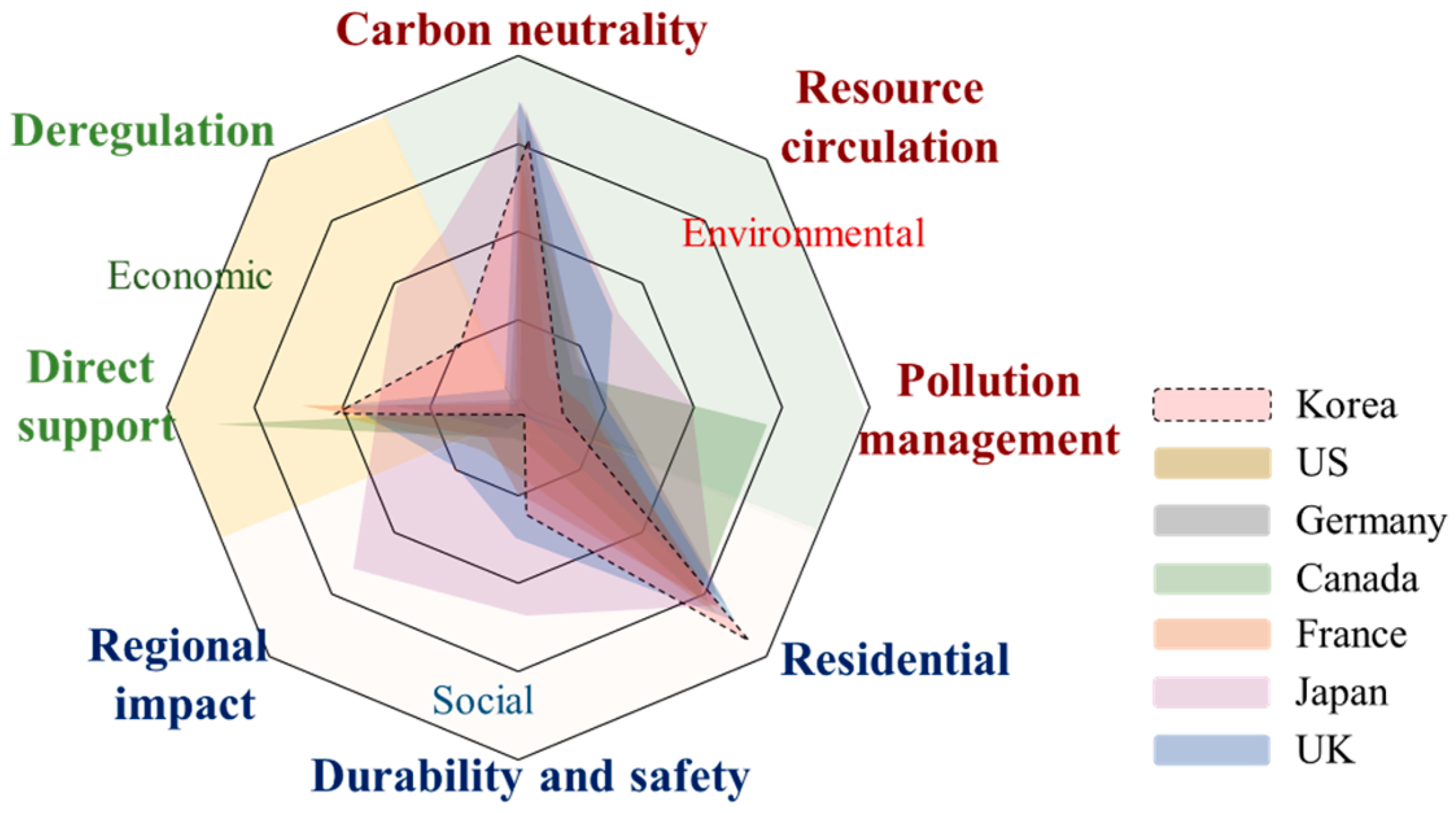
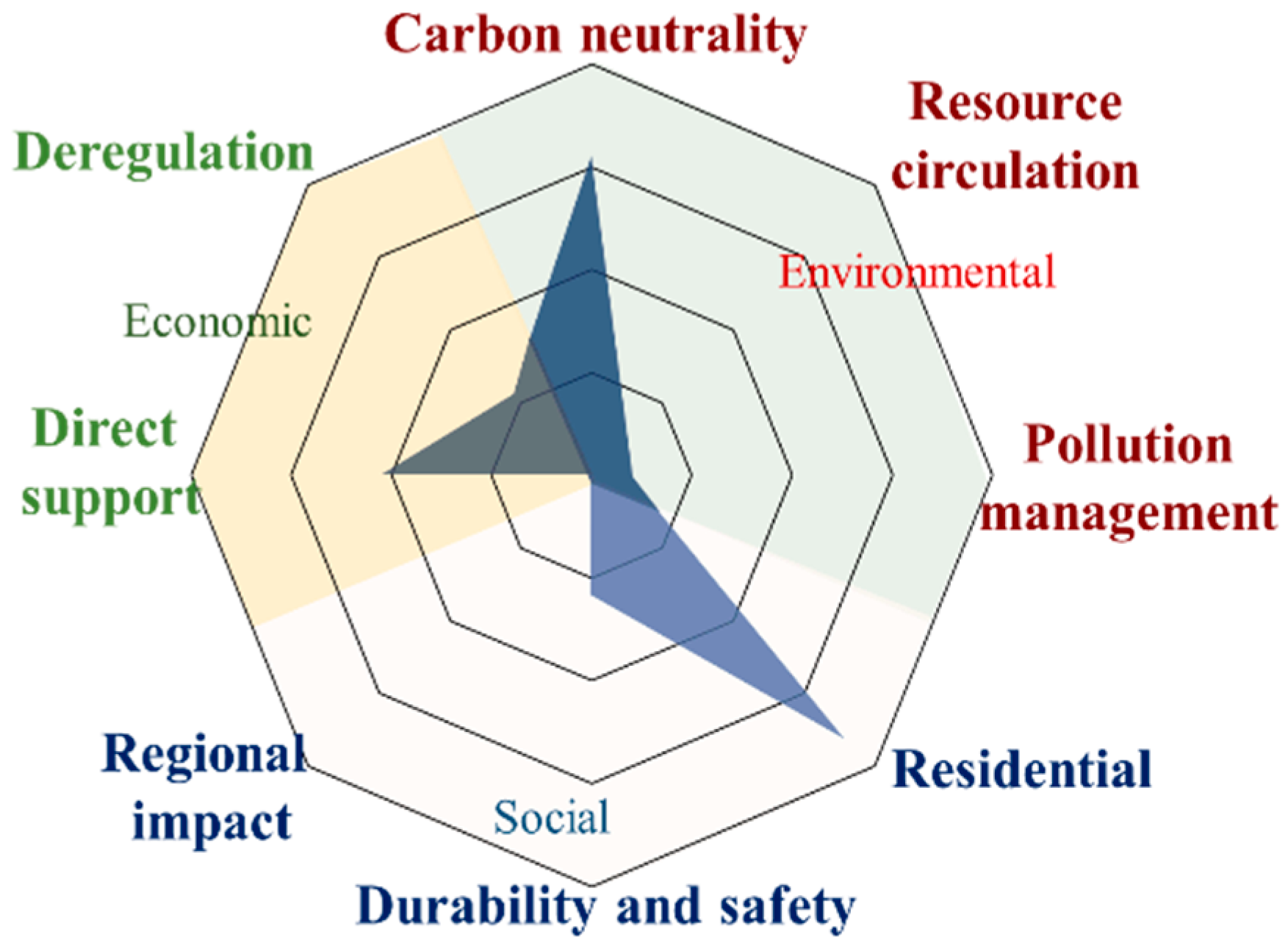
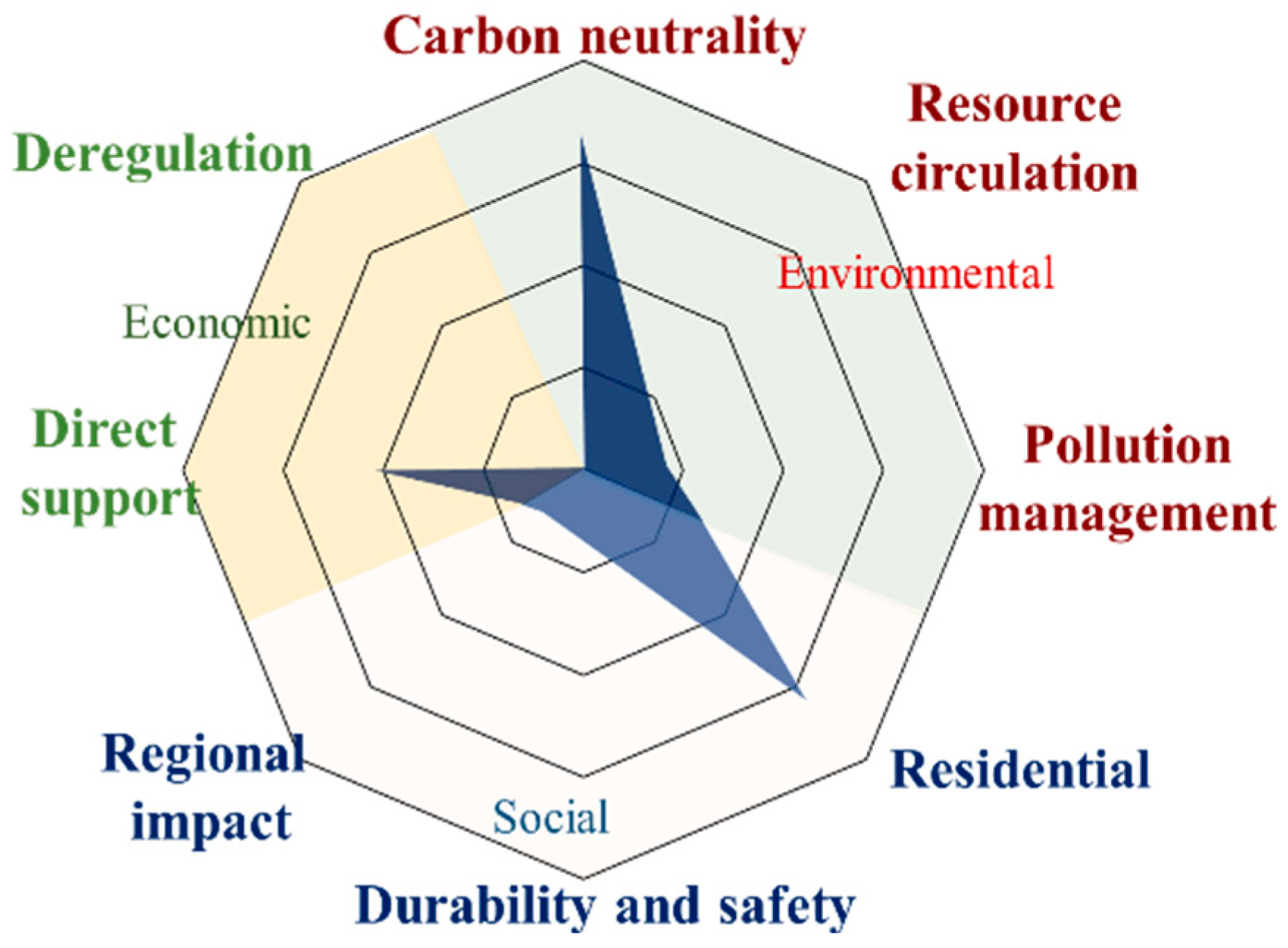
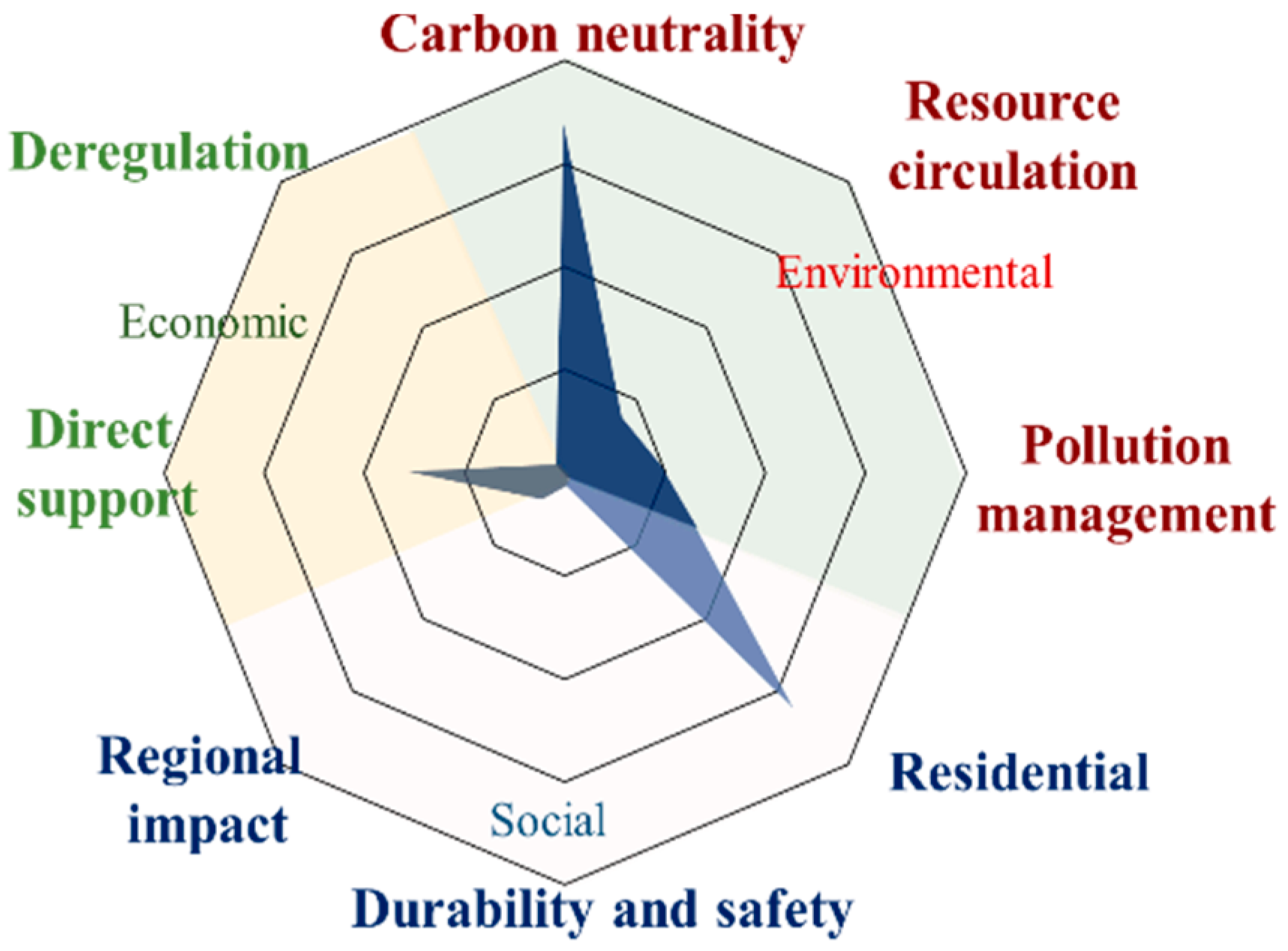

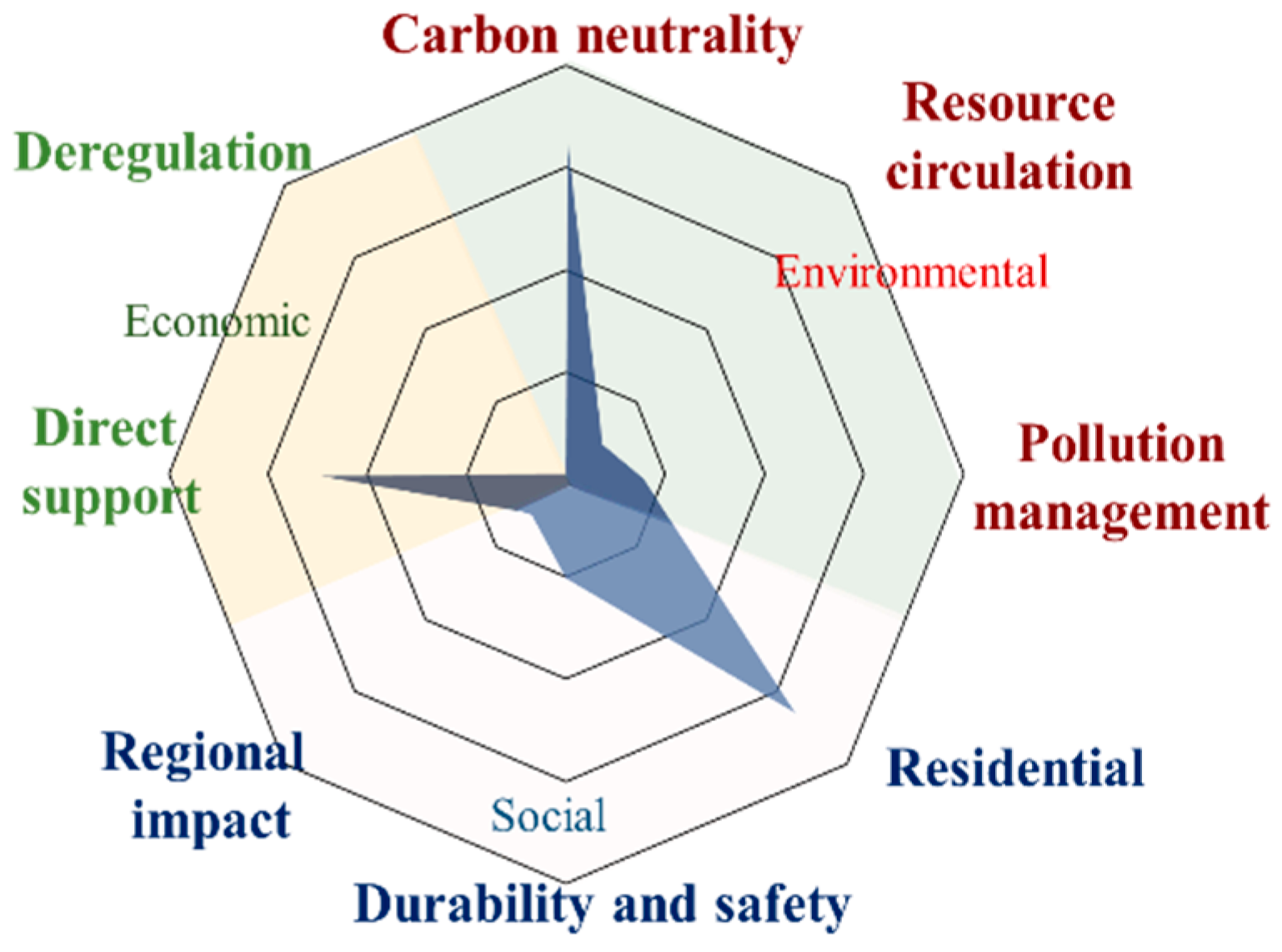
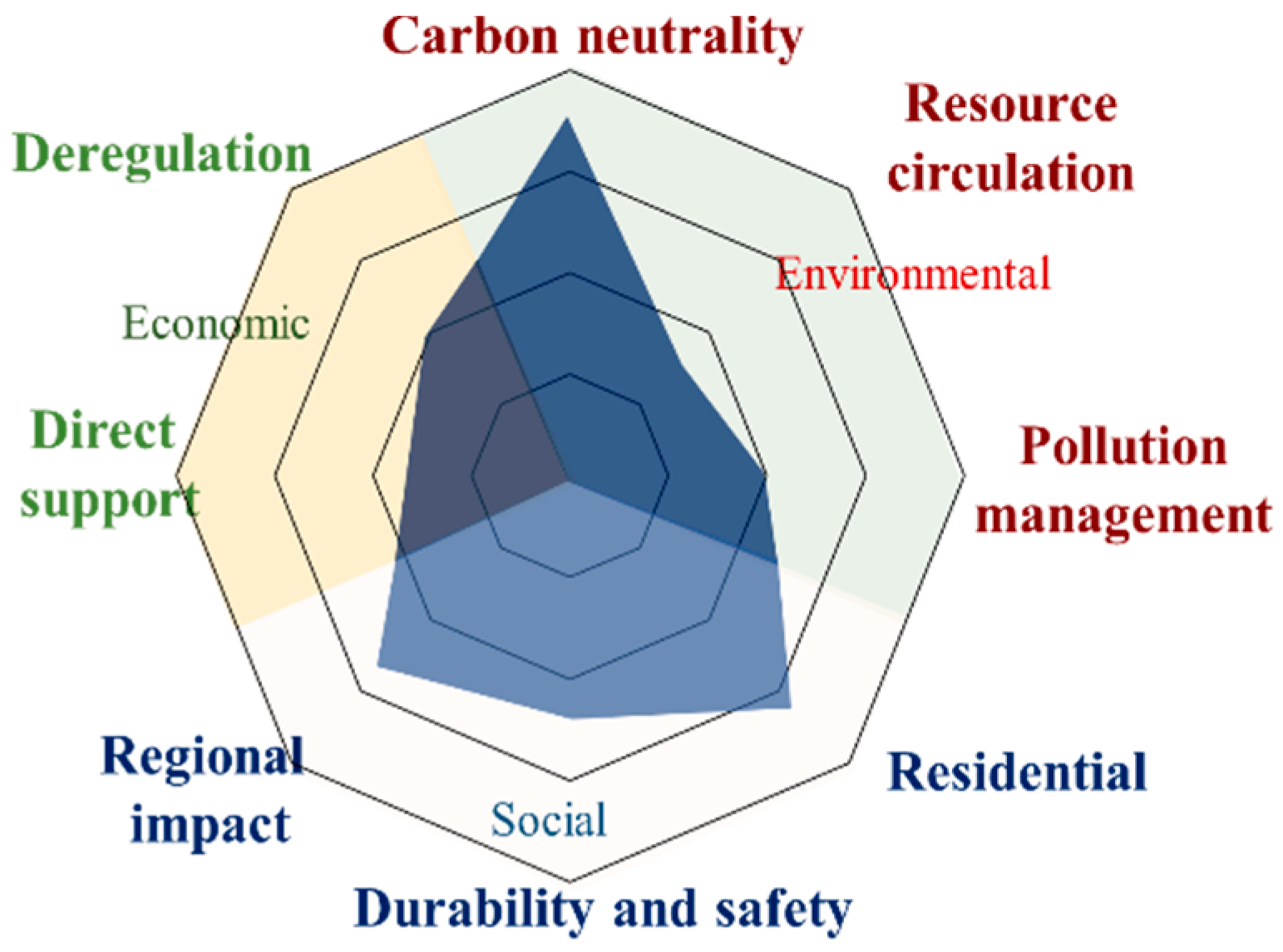
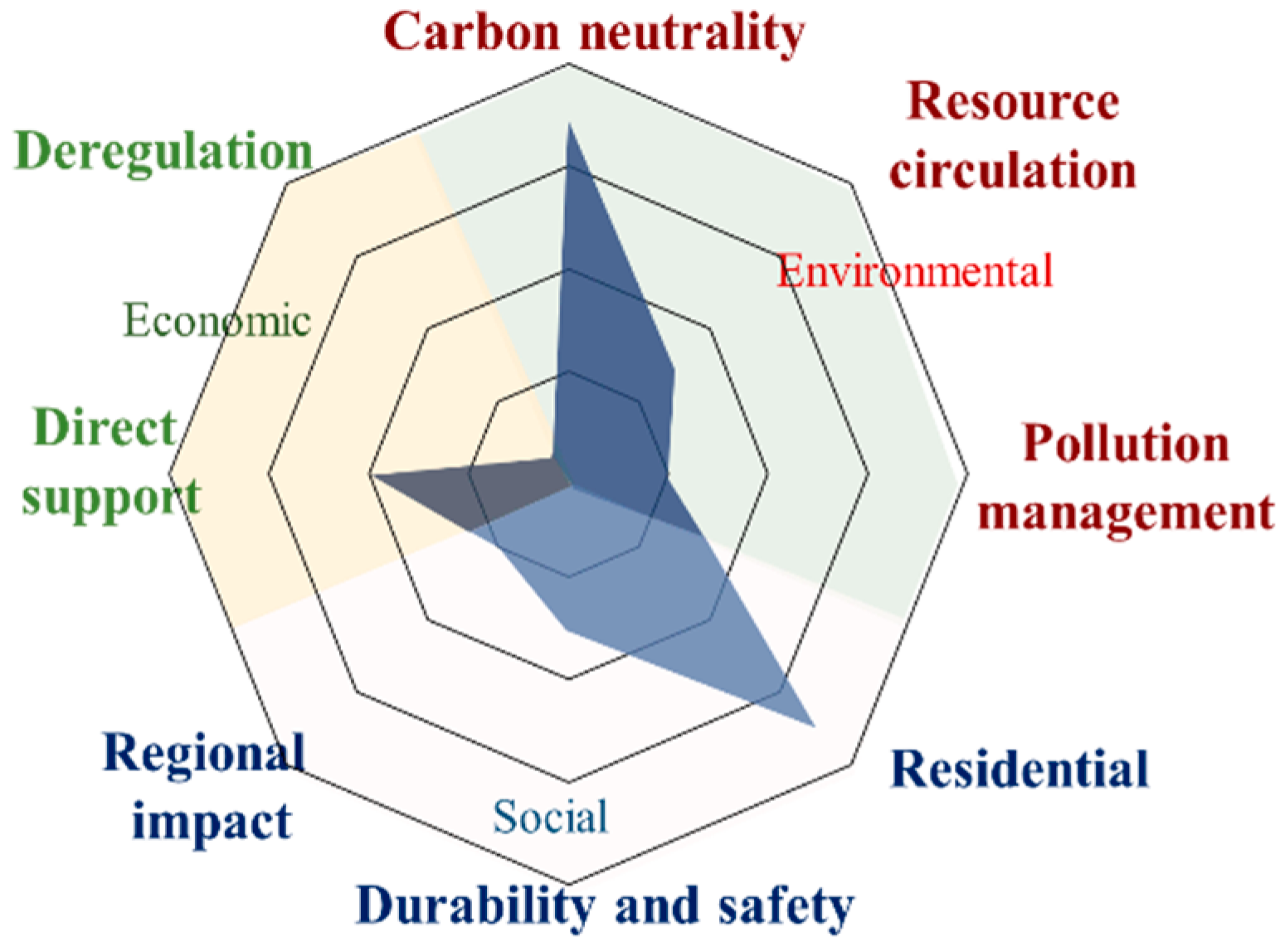
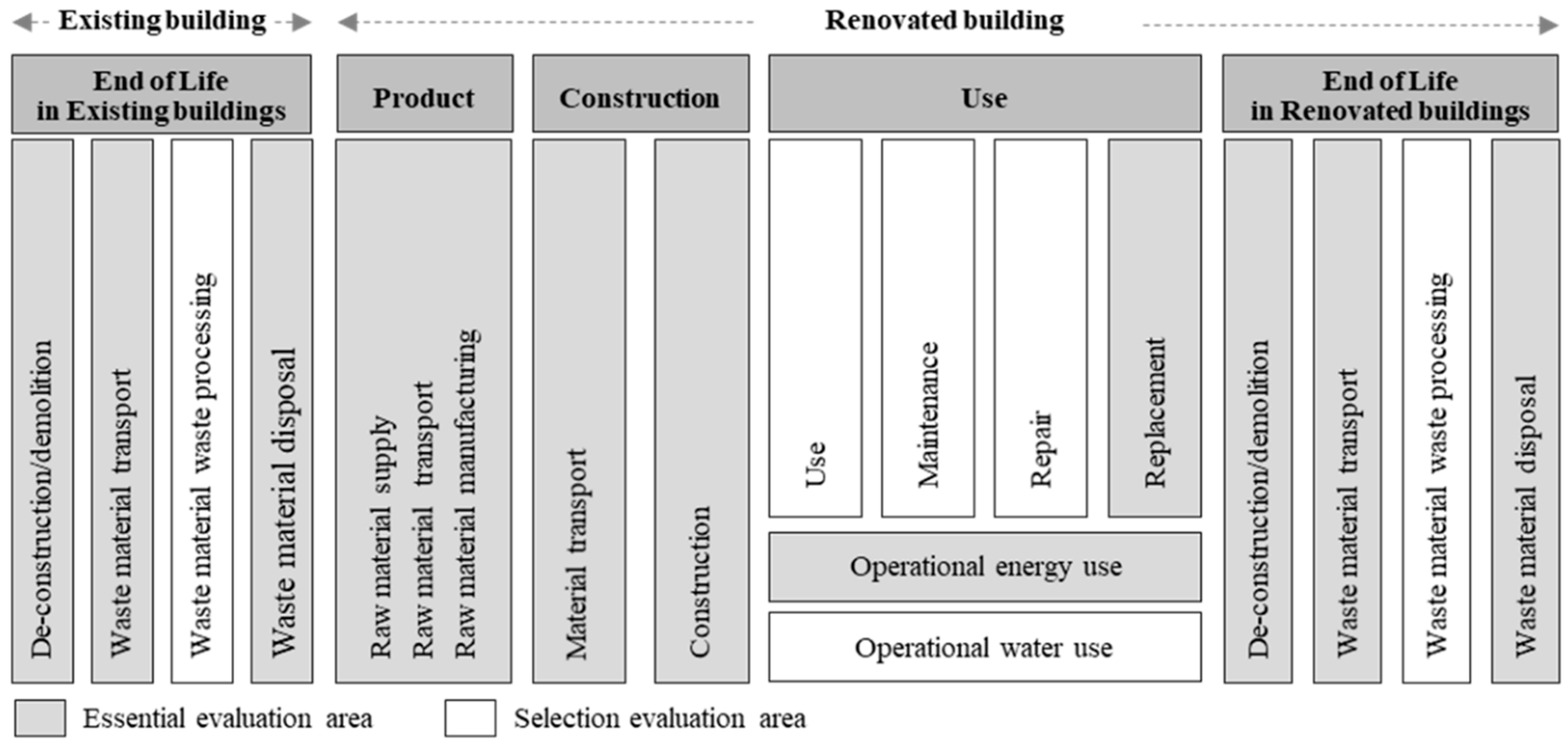
| Year | Authors | Main Topic | Research Areas and Limitations | Differences in This Study |
|---|---|---|---|---|
| 2023 | Ahmed et al. [22] | Sustainability |
|
|
| 2018 | Liang et al. [23] | |||
| 2015 | Choi [24] | |||
| 2025 | Sinha et al. [25] | Economic policy |
|
|
| 2023 | Marchi and Gaspar [26] | |||
| 2023 | Mushafiq and Arisar [27] | |||
| 2021 | Hwang et al. [28] | |||
| 2019 | Bravo et al. [29] | |||
| 2019 | Studer and Rieder [30] | |||
| 2019 | Liang et al. [31] |
|
| |
| 2018 | Mora et al. [32] | |||
| 2017 | Park and Jeong [33] | |||
| 2025 | Go [34] | Renovation |
|
|
| 2023 | Perez-Navarro et al. [35] | |||
| 2020 | Choi [36] | |||
| 2020 | Park [37] | |||
| 2017 | Satu and Ahvenniemi [38] |
|
| |
| 2015 | Kim and Youm [39] | |||
| 2014 | Jang et al. [40] | |||
| 2013 | Sim [41] | |||
| 2025 | Barbosa and Almeida [42] | Environmental tool |
|
|
| 2023 | Pulgar Rubilar et al. [43] | |||
| 2018 | Kim and Yoon [44] | |||
| 2018 | Gonzalez Caceres [45] | |||
| 2024 | Huang and Xu [46] | Framework |
|
|
| 2024 | Liu et al. [47] | |||
| 2015 | Malmgren and Mjörnell [48] |
| Pillar (Large Category) | Indicator (Medium Category) | Sub-Indicator (Small Category) |
|---|---|---|
| Environmental | (1) Carbon neutrality | ① High efficiency of energy facilities |
| ② Installation of renewable energy facilities | ||
| ③ Restriction of carbon emissions | ||
| (2) Resource circulation | ① Waste treatment | |
| ② Using reusable materials | ||
| ③ Recycling water | ||
| (3) Pollution management | ① Water pollutant management | |
| ② Air pollutants (NOx, PM, VOC, etc.) management | ||
| ③ Soil pollutant management (oil, fuel, waste, etc.) management | ||
| Social | (1) Residential | ① Social equity |
| ② Basic environment (sound insulation, lighting, insulation, ventilation, etc.) | ||
| ③ Comfortable environment (indoor air quality, temperature/humidity, etc.) | ||
| (2) Durability and safety | ① Resistance, durability | |
| ② Workers’ industrial safety | ||
| (3) Regional impact | ① Influence on the community | |
| ② Influence of the local ecosystem | ||
| Economic | (1) Direct support | ① Support, subsidy support |
| ② Tax deduction | ||
| (2) Deregulation | ① Construction standard relaxation (volume area ratio, etc.) |
| System and Policies | Sustainability (1),(2) | |||||||
|---|---|---|---|---|---|---|---|---|
| Environmental | Social | Economic | ||||||
| CN | RC | PM | Re | D&S | RI | DS | De | |
| South Korea | ||||||||
| 1. Improving energy efficiency for low-income families | ○ | ● | ||||||
| 2. Public building green remodeling support project | ● | ○ | △ | ● | ○ | ○ | ||
| 3. Green home housing support project | ○ | ○ | ○ | ○ | ||||
| 4. Green remodeling private support project | ● | ● | ● | |||||
| 5. Building retrofit project (BRP) loan support project | ● | ○ | ○ | |||||
| 6. G-SEED (Green Standard for Energy and Environmental Design) | ● | ○ | ● | ○ | ||||
| 7. Incentive system related to green building certification | ○ | ○ | ||||||
| 8. Public Procurement Service, Green Remodeling Order Guidelines | ○ | ● | ||||||
| 9. ESCO investment project | ● | ○ | ○ | |||||
| 10. Green school project | ● | ○ | ||||||
| 11. Seoul Dream Housing project | ○ | ○ | ||||||
| 12. Building Act | ○ | ● | ||||||
| 13. Housing Act | ○ | ● | ||||||
| Total of the medium categories | 22 | 4 | 3 | 25 | 8 | 0 | 15 | 8 |
| Total of the large categories | 29 | 33 | 23 | |||||
| United States (US) | ||||||||
| 1. Housing Repair and Weatherization | ○ | ● | ○ | ○ | ||||
| 2. PACE (Property Assessed Clean Energy) system | ● | △ | ○ | ○ | ○ | |||
| 3. Retrofit Chicago | ○ | ○ | ○ | |||||
| 4. Energy Smart Schools Program | ○ | ○ | ||||||
| 5. SFFW (Single Family Full Weatherization) | ○ | ● | ○ | |||||
| 6. Single Family ‘Specialty’ | ○ | ○ | ○ | |||||
| 7. Multi-family Weatherization | ○ | ○ | ○ | |||||
| 8. Home Repair | ○ | ● | ● | ○ | ○ | |||
| 9. Chicago Climate Action Plan | ○ | ○ | ○ | ○ | ||||
| 10. School Energy Efficiency Project Grant | ● | ○ | ○ | |||||
| 11. Better Buildings Neighborhood Program | ○ | ○ | ||||||
| 12. Climate Mobilization Act | ○ | ○ | ○ | |||||
| 13. Built Green | ○ | ○ | △ | ● | ○ | |||
| 14. LEED (Leadership in Energy and Environmental Design) | ● | ● | ○ | ● | △ | ○ | ||
| 15. NGBS (National Green Building Standard) Certification | ○ | ○ | ● | ○ | ||||
| Total of the medium categories | 33 | 9 | 9 | 32 | 7 | 6 | 22 | 0 |
| Total of the large categories | 51 | 45 | 22 | |||||
| United Kingdom (UK) | ||||||||
| 1. BREEAM (Building Research Establishment Environmental Assessment Method) | ● | ● | ○ | ● | ● | ○ | ||
| 2. Green Deal | ○ | ○ | ○ | |||||
| 3. Energy supplier efficiency improvement obligation system | ○ | ● | ○ | |||||
| Total of the medium categories | 7 | 3 | 2 | 7 | 3 | 2 | 4 | 0 |
| Total of the large categories | 12 | 12 | 4 | |||||
| Germany | ||||||||
| 1. CO2 Building renovation program. | ● | ○ | ○ | |||||
| 2. EnEV (Energy Saving Ordinance) | ● | ● | ||||||
| 3. Energy Efficient Refurbishment | ● | ○ | ● | ○ | ||||
| 4. School of the Future Project | ● | ○ | ○ | |||||
| 5. ELENA (European Local Energy Assistance) | ○ | ○ | ||||||
| 6. DGNB (Deutsche Gesellschaft fur Nachhaltiges Bauen) | ○ | ○ | ● | ○ | ||||
| 7. EnerPhit | ● | ○ | △ | ● | ||||
| Total of the medium categories | 17 | 4 | 5 | 16 | 0 | 2 | 8 | 0 |
| Total of the large categories | 26 | 18 | 8 | |||||
| Canada | ||||||||
| 1. HPNC (High Performance New Construction Program) | ○ | ○ | ○ | ○ | ||||
| 2. Hi-RIS (High-Rise Retrofit Improvement Support) | ● | ● | ○ | ○ | ||||
| 3. HELP (Home Energy Loan Program) | ● | ○ | ○ | |||||
| 4. Eco-Roof Incentive Program | ○ | ● | ● | |||||
| Total of the medium categories | 8 | 2 | 7 | 7 | 0 | 0 | 9 | 0 |
| Total of the large categories | 17 | 7 | 9 | |||||
| France | ||||||||
| 1. PAH (Pretal’ Am elioration de l’ Habitat) | ○ | ● | ○ | ○ | ||||
| 2. eco-PTZ (eco-Pret a Taux Zero) | ● | △ | ○ | ○ | ||||
| 3. Plan de Renovation Energetique de l’Habitat | ○ | ○ | ○ | |||||
| 4. Credit d’ impot developpement durable | ○ | ○ | ○ | |||||
| 5. Eco-pret logement social | ○ | ○ | ○ | |||||
| 6. HQE (Haute Qualite Environnementale) | ○ | ○ | ○ | ○ | ○ | ○ | ||
| Total of the medium categories | 13 | 2 | 3 | 13 | 4 | 2 | 10 | 0 |
| Total of the large categories | 18 | 19 | 10 | |||||
| Japan | ||||||||
| 1. Eco-Flow | ● | ○ | ○ | ○ | ||||
| 2. Eco School Plus | ○ | △ | ○ | ○ | ||||
| 3. Building Standards Act | ○ | ● | ||||||
| 4. CASBEE(Comprehensive Assessment System for Built Environment Efficiency)-Retrofit | ○ | ○ | ○ | ● | ○ | ● | ||
| Total of the medium categories | 7 | 4 | 3 | 5 | 4 | 7 | 2 | 3 |
| Total of the large categories | 14 | 16 | 5 | |||||
| Item | Description |
|---|---|
| 1. Project name |
|
| 2. Development purpose |
|
| 3. Operating system |
|
| 4. Support target |
|
| 5. Support conditions |
|
| 6. Support items |
|
| Country | Environmental (1) | Social (1) | Economic (1) | SRI | |||||
|---|---|---|---|---|---|---|---|---|---|
| CN | RC | PM | Re | D&S | RI | DS | De | ||
| South Korea | 56.4% | 10.3% | 7.7% | 64.1% | 20.5% | - | 38.5% | 20.5% | 27.2% |
| United States | 73.3% | 20.0% | 20.0% | 71.1% | 15.6% | 13.3% | 48.9% | - | 32.8% |
| United Kingdom | 77.8% | 33.3% | 22.2% | 77.8% | 33.3% | 22.2% | 44.4% | - | 38.9% |
| Germany | 81.0% | 19.0% | 23.8% | 76.2% | - | 9.5% | 38.1% | - | 31.0% |
| Canada | 66.7% | 16.7% | 58.3% | 58.3% | - | - | 75.0% | - | 34.4% |
| France | 72.2% | 11.1% | 16.7% | 5.6% | 22.2% | 11.1% | 55.6% | - | 24.3% |
| Japan | 58.3% | 33.3% | 25.0% | 41.7% | 33.3% | 58.3% | 16.7% | 25.0% | 36.5% |
Disclaimer/Publisher’s Note: The statements, opinions and data contained in all publications are solely those of the individual author(s) and contributor(s) and not of MDPI and/or the editor(s). MDPI and/or the editor(s) disclaim responsibility for any injury to people or property resulting from any ideas, methods, instructions or products referred to in the content. |
© 2025 by the authors. Licensee MDPI, Basel, Switzerland. This article is an open access article distributed under the terms and conditions of the Creative Commons Attribution (CC BY) license (https://creativecommons.org/licenses/by/4.0/).
Share and Cite
Jo, K.; Wang, S. Development of an Indicator-Based Framework for a Sustainable Building Retrofit. Buildings 2025, 15, 3191. https://doi.org/10.3390/buildings15173191
Jo K, Wang S. Development of an Indicator-Based Framework for a Sustainable Building Retrofit. Buildings. 2025; 15(17):3191. https://doi.org/10.3390/buildings15173191
Chicago/Turabian StyleJo, Kanghee, and Seongjo Wang. 2025. "Development of an Indicator-Based Framework for a Sustainable Building Retrofit" Buildings 15, no. 17: 3191. https://doi.org/10.3390/buildings15173191
APA StyleJo, K., & Wang, S. (2025). Development of an Indicator-Based Framework for a Sustainable Building Retrofit. Buildings, 15(17), 3191. https://doi.org/10.3390/buildings15173191







